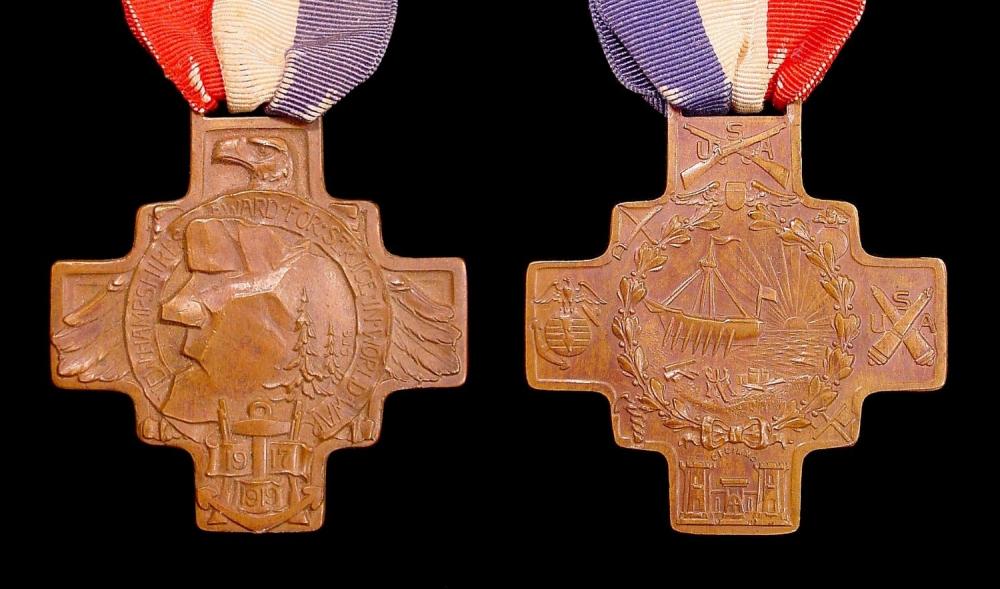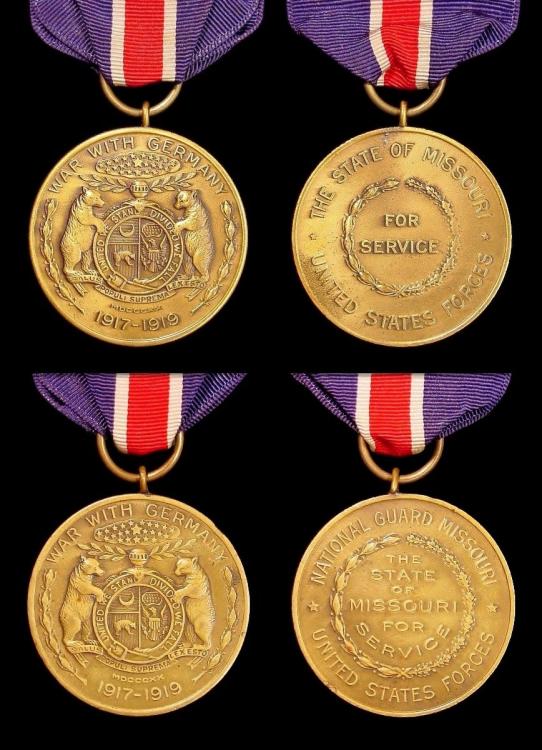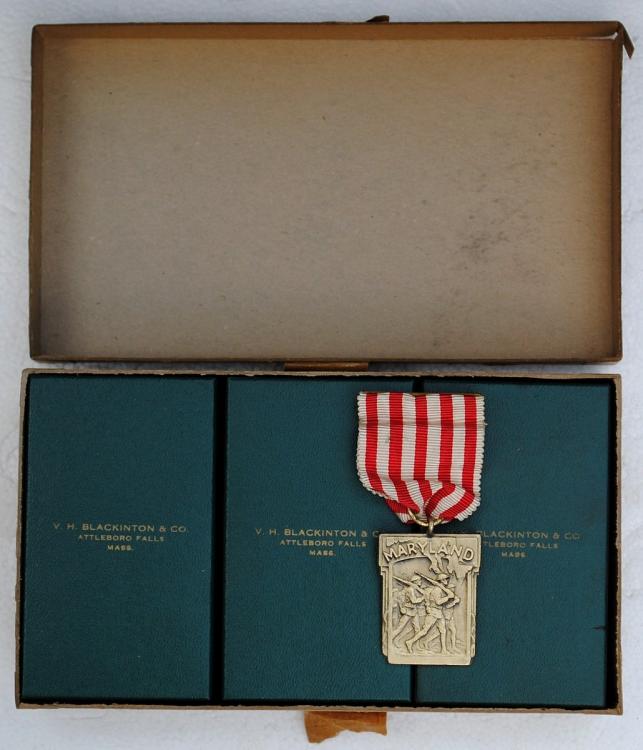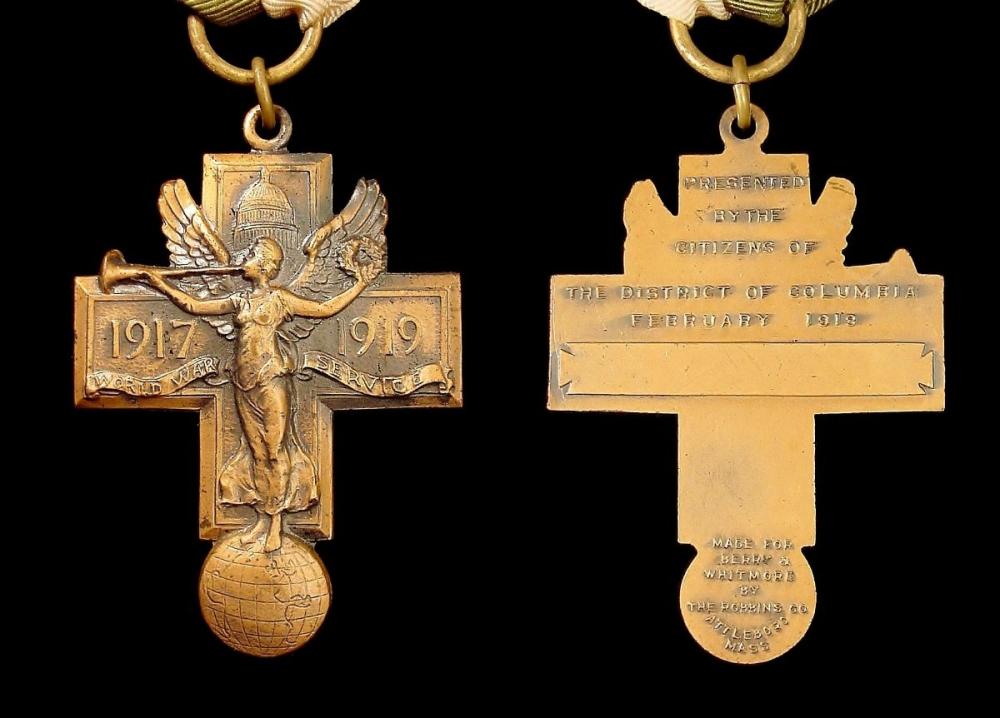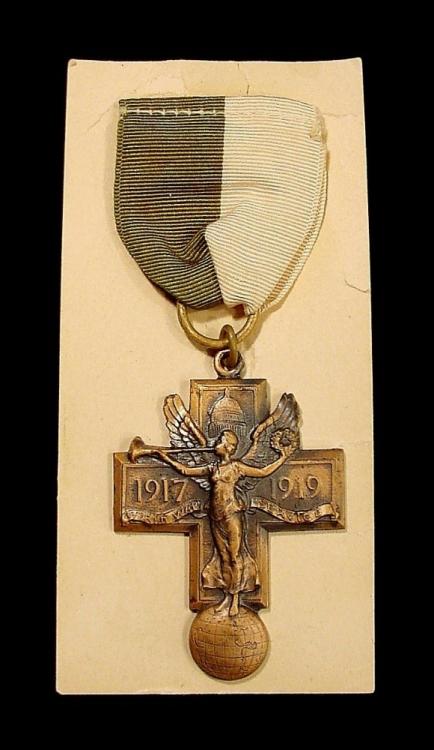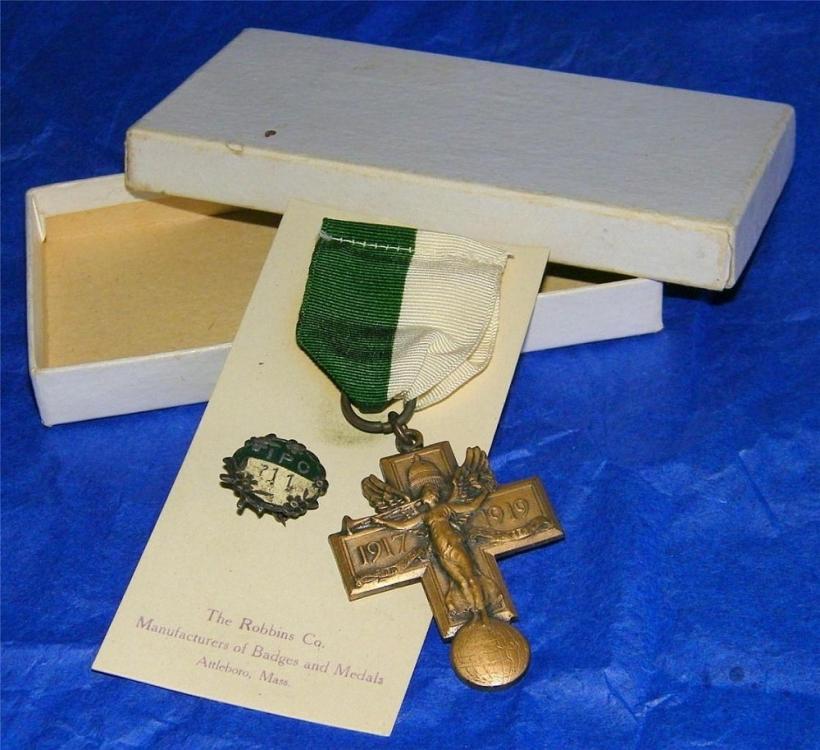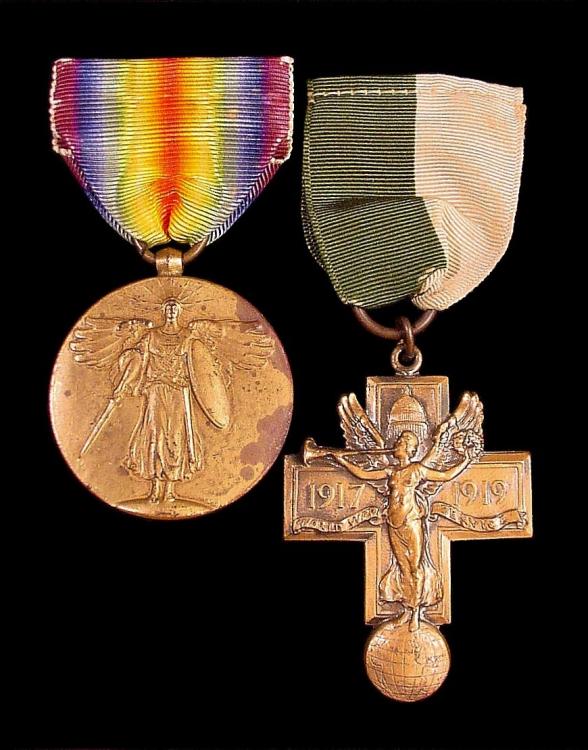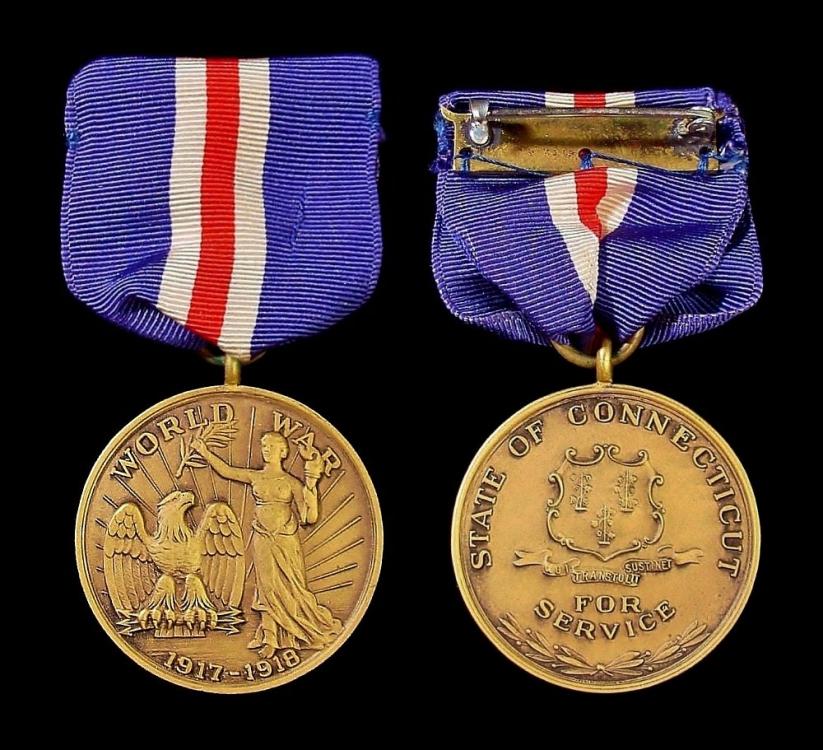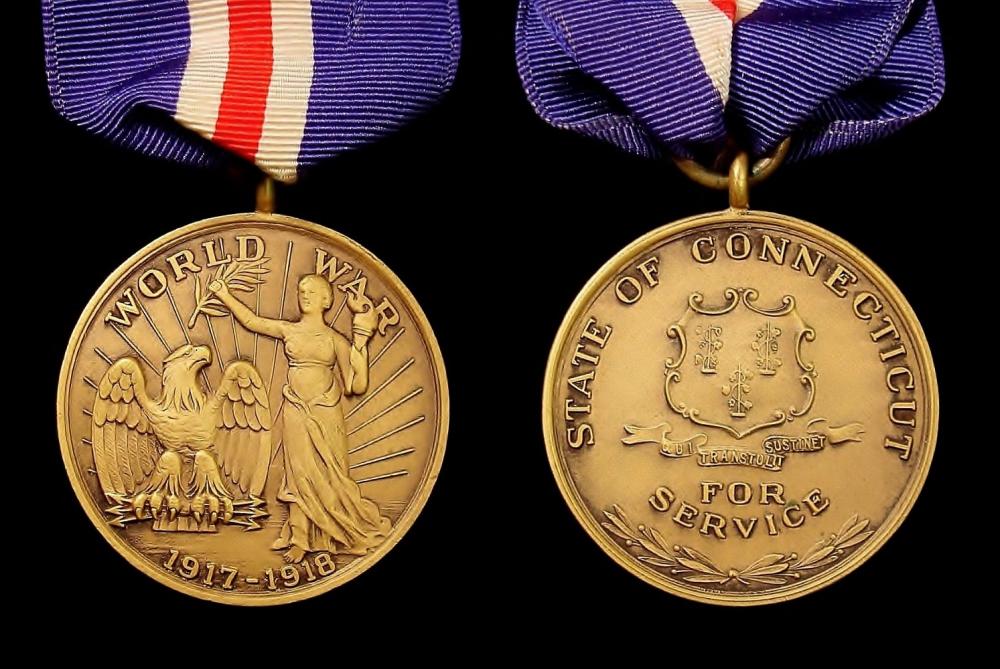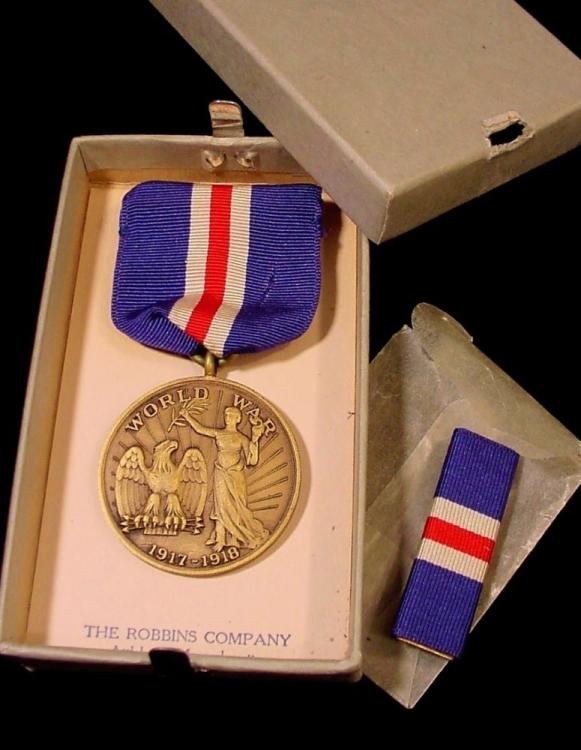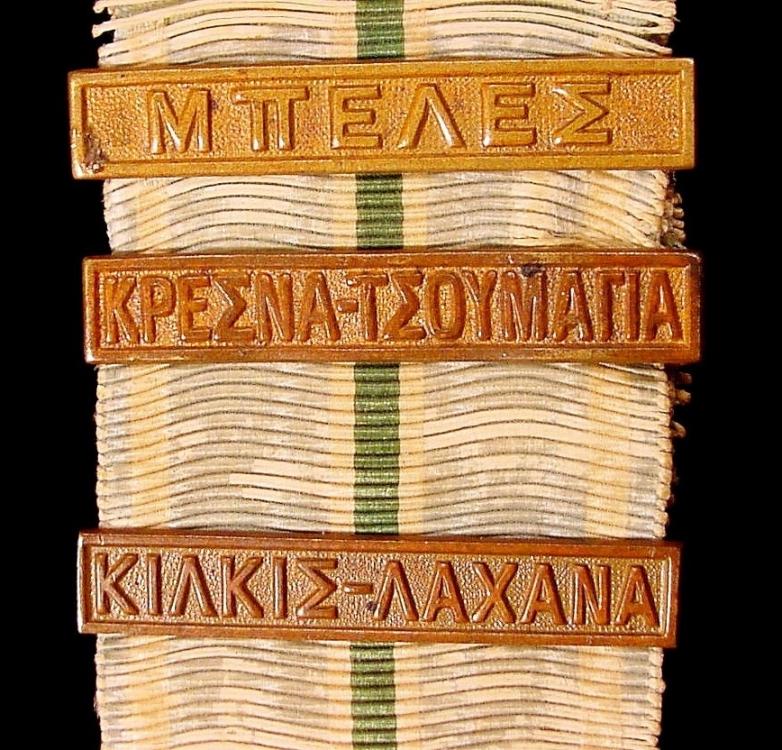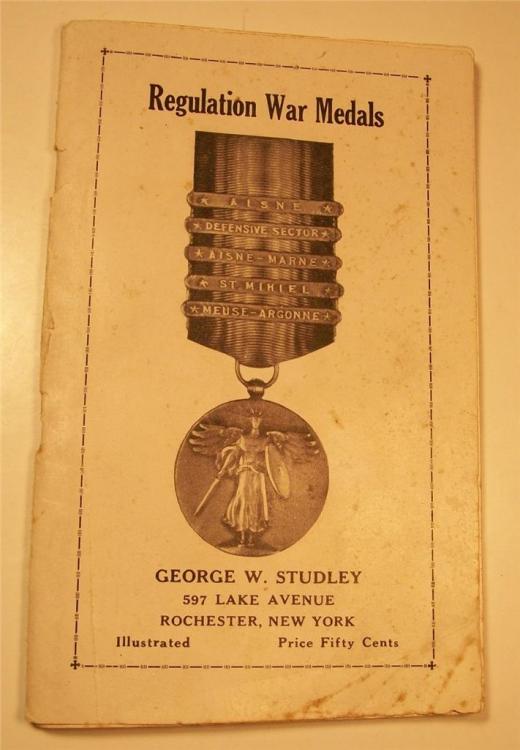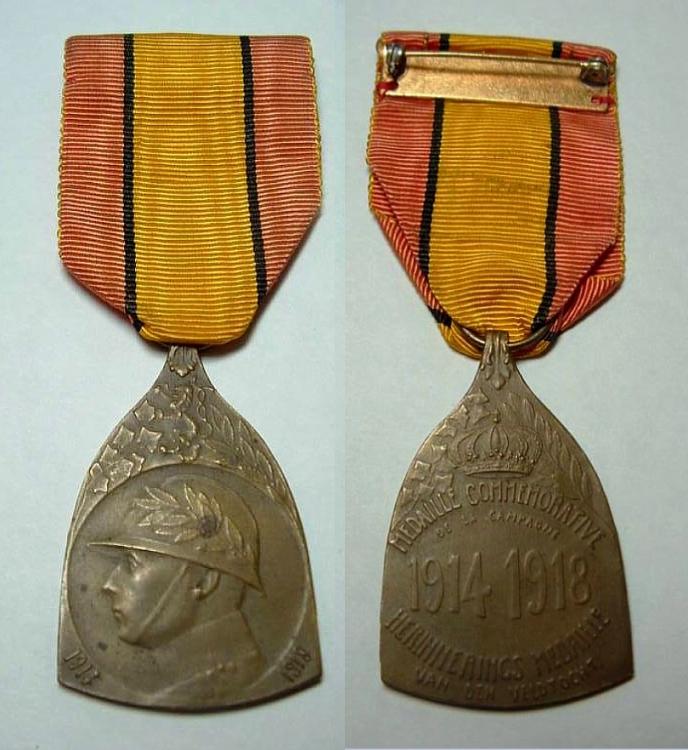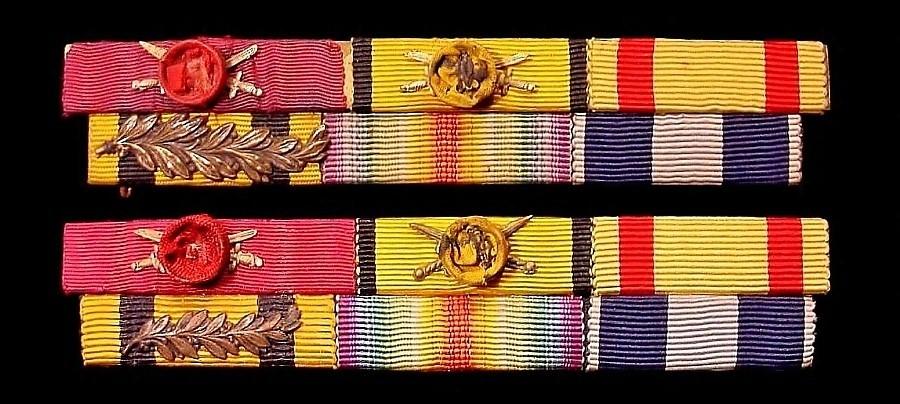
Tim B
Past Contributor-
Posts
2,234 -
Joined
-
Last visited
-
Days Won
2
Content Type
Profiles
Forums
Blogs
Gallery
Events
Store
Everything posted by Tim B
-
New Hampshire World War Service Medal 1917 – 1918 Established by Chapter 40, New Hampshire Laws of 1919. Awarded upon application to residents of New Hampshire who served in World War 1 against the Government of Germany. The medal was accompanied with a certificate from the State. A very bold design with the State’s landmark “Man of the Mountains” superimposed over an eagle. Close inspection of the obverse and reverse shows symbols of various branch emblems of the military. Though the medal is appearing more often of recent, its suspension ribbon is not always in the greatest condition and the award is seldom seen with the box of issue.
-
Missouri WW1 Service Medals Missouri is one of those States that have always recognized their veterans and honored their service with awards. This is true with both active Federal Service as well as National Guard and during most periods of conflict, has authorized medals differentiating between the two. Here's a quick comparison of both medals: Missouri War With Germany – U.S. Forces Approved by the General Assembly on April 27th, 1919. Awarded to all persons who as citizens and residents of Missouri served in the armed forces of the United States for any period between April 6th, 1917 – November 11th, 1918 inclusive. This was the federal medal and only awarded to active duty personnel, not those in the National Guard. War With Germany – National Guard Missouri The General Assembly actually approved the National Guard medal three days earlier, on April 23rd, 1919. Awarded to members of the National Guard of Missouri who, on August 5th, 1917 or thereafter were called into military service of the United States and served for any period between such date and November 11th, 1918. Missouri used a rather plain and simple small brown box to issue these medals in and similar boxes were used for the Mexican Border Service Medal and I assume both versions of the War With Spain Medal.
-
Maryland World War Service Medal Approved April 13th, 1922 by the State Legislature. Awarded to all residents of the State who saw active service during World War 1. This included about 50,000 in both regular Army as well as National Guard forces. As you can see, many of these state issues can still be found in mint condition in the original box of issue, though some States are rather hard to find at all. Apparently, sometime recent, a hoard was located and found its way onto the market.
-
District of Columbia World War Service Medal As was in the case for the DC Spanish American War Medal, the awarding authority was actually a citizen committee which procured funds through public solicitation. In 1919, the Citizen Committee of Washington, D.C., formed as part of the International Festival of Peace celebrating victory over Germany and funds were allocated for the production of the medal which was presented on behalf of the citizens at a 4th of July ceremony which took place on the Washington Monument grounds. Of the estimated 15,000 medals struck, approximately 8000 were awarded at the ceremony. The medal was also later available upon application through the National Guard. The D.C. medal was produced by the Robbins Company for Barry & Whitmore and is one of only two that utilized a safety pin style of attachment sewn to the ribbon. It is one of my personal favorites in artistic design. Here's one of mine on the unmarked card: Apparently they also came marked by Robbins, as this boxed example shows. Another one of mine; this set was issued to a William Fechtig who enlisted in 1918 and too late to embark overseas.
-
Connecticut WW1 Service Medal Special Act #336 of the General Assemblies approved this award on June 6th, 1929. Awarded to each veteran who was a citizen of Connecticut at time of entry into the service. Of the approximate 52,000 soldiers that qualified (Federal and National Guard), only about 9000 actual medals were awarded through June 1936. Perhaps that’s why we see so many still near mint condition in the original box of issue? Connecticut had a rather unique box of issue with the two metal tabs. Complete with service ribbon and manufacturer's information on the card and hallmark on the service ribbon reverse.
-
So, looking at the large group photo above, I will only be working with the bottom two rows that apply to WW1. The rows are split into Federal and National Guard service and as time permits, I will add mine alphabetically, no real reason why, just easy to remember. Feel free to add others at your leisure. Tim First up for me: Colorado Active Service Medal Established April 14th 1931 and confirmed into the Colorado National Guard on November 16th of the same year. It was awarded only in cases where no other Federal or State campaign medal was previously awarded. As Colorado did not authorize a specific campaign medal for WW1 service, this was the only medal that recognized National Guardsmen that served in active service during that war. This period of service had to exceed seven days duration unless casualties were sustained and then a lessor time period was sufficient credit for the award. Supposedly, there was a bronze clasp worn to denote participation in the specific campaign. For WW1, it would be for Active duty, not in Federal Service, Apr 6, 1917 – Jun 10, 1919 inclusive. The clasp would read simply “1917 – 1918”. Note: I personally have never seen a clasp for WW1 service as mentioned above, only an example for Vietnam Service attached to the service ribbon bar. If anyone has one, please post it somewhere in this thread as I would really like to see an example. The obverse is pretty typical of Colorado National Guard Service Medals with the state's coat of arms surmounted by an eagle with spread wings and shield. The medal was discontinued in September, 1963 and only the ribbon bar with appropriate clasp was awarded thereafter. Most of these state issued medals came in a box or envelope of issue. Not 100% sure in Colorado's case but I tend to think envelope for some reason. Here's the medal on the original Whitehead & Hoag card:
-
Hi Lambert, Yes, we see this everywhere, even in today's modern examples. I think it comes down to two things: 1) Who is doing the mounting and what capabilities/experience they have in mounting medals. 2) How much money you want/can pay to have them mounted. In the first case, uniform shops often have someone on staff or some outside vendor that does this and it all depends on the individual doing the work. I've had my medals mounted several times over a 20+ career. Sometimes they simply remove the original suspension ribbon and use material on a roll, sometimes they cheap out and cut and re-use that original ribbon. Backing material has been anywhere from very nice to nothing. In the second case, back in the day, I would imagine the person would have to find someone in the business and pay whatever those costs were. Again, how nice of a setup you get probably is determined how much you can afford or want to spend on it. I knew guys that didn't want to pay and would often take the back attachment pin off and slide the medals on a ribbon bar rack. Didn't look the best but for a few medals it worked. Tim
-
Looks fine, has the Paris Mint hallmark on it, so you know its official. Search this forum for French hallmarks and you can read up more on these. Tim
-
Hello Carey, Well, the thread is a bit old but let's show some comparisons and see what you think. First, a group of CdG and from this distance, does any one stand out a bit different from the rest? If you click on the photo, you can see it enlarged and maybe see some difference? Now, if you look at all of them, minor differences in some details which are probably attributed to manufacturer's but all except the one in question has more of a pebbling in the cross arms. Here's a close up of that one and one of the others with the pebbling. Note also the overall finish of the one in question, to me and some others it appears more modern.
-
Hello Lambert, I'm not sure what you meant by "brings" but here's a shot of the reverse of the medal bar. Hard to show much more as for the construction as its sewn fairly well. I left the pic large so you should be able to see details. The set actually came with two ribbons bars, both identical setups but the attachments have some interesting variations. I am trying to ask more about it in the Greek medal section but have found little interest as of yet. If you need to see anything else, just let me know! Tim
-
Thanks Rob!
-
Greek Medal Bar - Research Possible?
Tim B replied to Tim B's topic in Southern European & Balkan States
Well... apparently not. Along those lines, is there anyway to research a named individual that participated in the Balkan War's? I have both the 1912 and 1913 war medals awarded to Christodoulos Christos George but, I have no more information on the person and would like to know more about his career if possible. Here's the 1912 Greek / Turkish War Medal with named box of issue (For King and Country): Here's his 1913 Greek / Bulgaria War Medal (Victories). -
I've been away for sometime and see this area never really took off, though I understand its more of a niche for those interested in state or local issues. I do hope to be able to add some interesting things here and maybe renew some interest in days/weeks to come. Tim Resolution is poor as original is 23 Mb
-
Bill, Yes, I believe I did. Happy to see you still here and the Vic section seems to be doing well!
-
Belgium Belgium - Commemorative Medal of the War 1914-1918
Tim B replied to a topic in Northern European & Baltic States
Carey, I'm not sure if any of the foreign awards were actually manufactured in the U.S. or only marketed and sold here. In the case of Studley, he procured his items from outside sources, some in the U.S., others..? The French made a lot of awards for other countries as well. I should add that the catalog page shown above came out of a June '43 Studley catalog however, the catalog appears mostly unchanged from an earlier version with minor changes made to the text and prices. Here's another page(s) 2-3 and you can compare. Tim -
Belgium Belgium - Commemorative Medal of the War 1914-1918
Tim B replied to a topic in Northern European & Baltic States
I meant to add this regarding the highly detailed version of the commemorative medal discussed above. In the June 1943 George Studley catalog, you can see he was offering various foreign awards and the Belgian WW1 Commemorative Medal is of the style shown with the longer neck. -
Thank you my friend, good to be back! Cheers!
-
Belgium Belgium - Commemorative Medal of the War 1914-1918
Tim B replied to a topic in Northern European & Baltic States
Here are some of mine with the more common variety of attachments. As you can see, the red cross came in several shapes and sizes. I only have the one medal bar with the fairly common setup. Tim -
Belgium Belgium - Commemorative Medal of the War 1914-1918
Tim B replied to a topic in Northern European & Baltic States
Hello gentlemen, Been awhile for me here. The examples Rob posted above appear to be quite common in U.S. groupings where the serviceman received awards from the Belgian government. Here are some old file PIC's I've saved. First pic: shorter neck with the areas notated. Second pic: longer neck version. Third pic: showing the sew-on style brooch commonly used by U.S. personnel. I've seen this in groups and a couple of made up bars as well. Tim -
-
Greek Medal Bar - Research Possible?
Tim B replied to Tim B's topic in Southern European & Balkan States
Hi Claudius, Thank you for your comments and answers here. There is another possibility, that he either wanted to keep the rather high award separate (cased w diploma/certificate) or, as the George Order fell out of favor with the government at the time (circa 1926), perhaps he didn't wear it or even receive the actual medal. ??? Here's the close up of the 1940 bar, best I can at this resolution. Also, I included a photo of the two medal bars as it shows slight variations in attachments, which I thought was nice. Warm regards, Tim -
jonsey2001, The device is a Model 1937 officer dress cap badge for the dress cover. I believe they continued to be used up until the late 1950's though this one appears to be either pre-WW2 or early war. The looped rope fouling is the indicator. Nice looking! What's the size on your example? I've never seen one with the pin setup like yours. Can we see a side view showing the pin better? Tim Three examples: dress sterling / service sterling / service bronze

